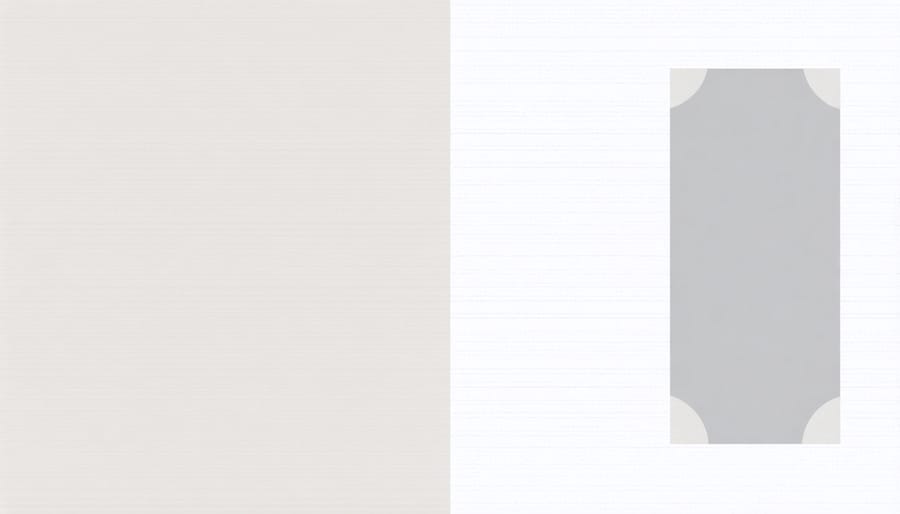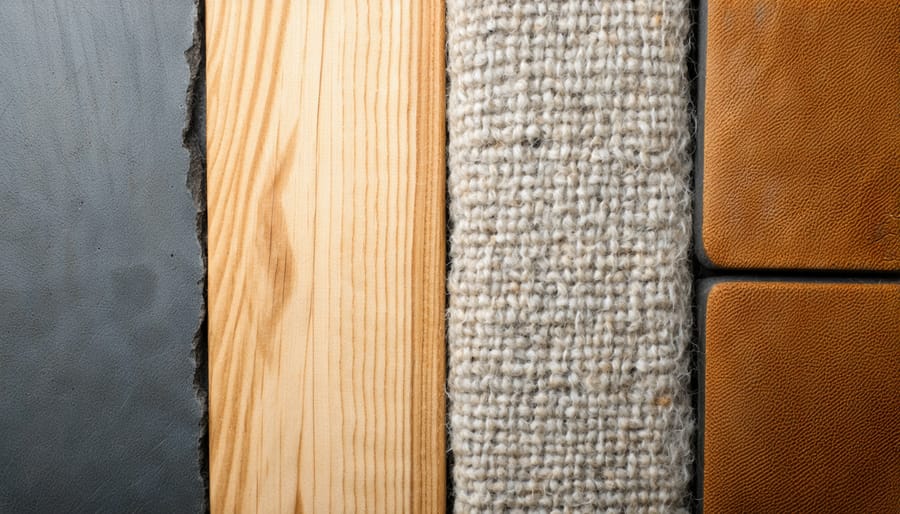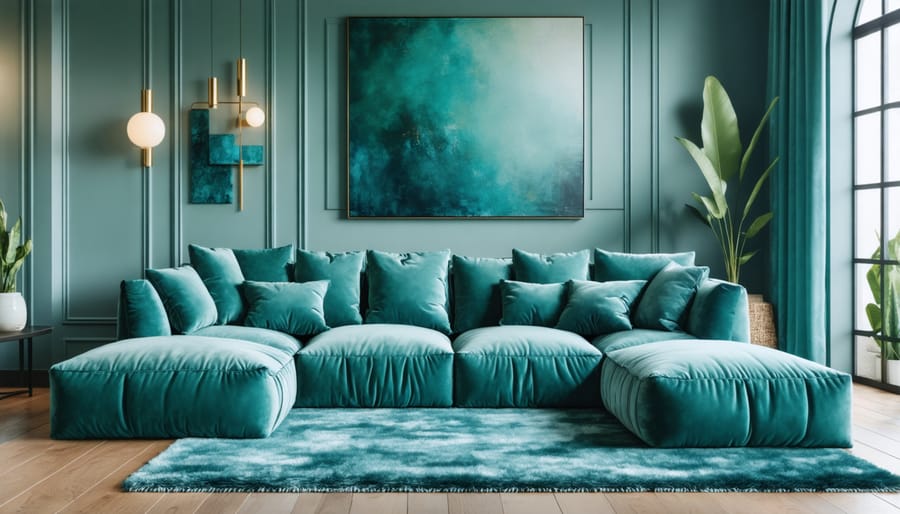Transform your living spaces by mastering the four fundamental textures in art: visual, tactile, actual, and implied. Understanding texture and color perception unlocks endless possibilities for creating depth, interest, and emotional resonance in your home’s design. These distinct texture types work together like instruments in an orchestra, each playing a crucial role in the overall composition of your space. Whether you’re selecting wall treatments, choosing fabrics, or arranging decorative elements, knowing how to leverage these textures will elevate your interior design from simple to sophisticated. From the smooth gleam of polished marble to the rough warmth of natural wood grain, textures speak a universal language that engages both sight and touch, transforming ordinary rooms into extraordinary experiences.
Visual Texture: Creating Depth Through Patterns
Printed and Painted Textures
Printed and painted textures offer a fascinating way to play with color perception in your home. When you look at wallpapers or fabrics with intricate patterns, you’ll notice how different textures can make colors appear deeper, lighter, or even change their apparent tone completely.
Take wallpapers with raised patterns, for instance. These create subtle shadows and highlights that can make a single color appear as multiple shades, adding depth to your walls without needing multiple paint colors. Similarly, grasscloth wallcoverings can make light colors appear warmer and more inviting due to their natural weave catching light at different angles.
In painted finishes, techniques like color washing or dry brushing can create an illusion of texture that affects how we perceive the base color. A color-washed wall might use the same paint color throughout, but the varying opacity creates a sense of movement and depth that can make the space feel more dynamic.
Fabric patterns also play a crucial role in color perception. A damask pattern in tone-on-tone colors can make a simple beige appear more sophisticated, while a geometric print can make colors appear more vibrant due to the contrast between pattern elements.
For the best results, always test your chosen printed or painted textures in your space under different lighting conditions. What looks subtle in the store might appear more pronounced at home, especially with natural light throughout the day.

Digital and Photographic Elements
In today’s digital age, creating texture doesn’t always require physical materials. Photography and digital printing have opened up exciting possibilities for adding visual texture to your space. High-resolution photographs of natural textures like wood grain, stone, or fabric can create stunning illusions that fool the eye while remaining completely smooth to the touch.
Digital printing technology allows for incredibly detailed reproductions of textural elements on various surfaces. For instance, wallpapers can now perfectly mimic the look of brick, marble, or even leather, offering a cost-effective alternative to natural materials. These printed textures work particularly well in modern interiors where a clean, controlled appearance is desired.
Professional photographers often capture extreme close-ups of textural subjects, creating abstract images that celebrate the intricate patterns found in nature. These photographs can serve as striking wall art while adding perceived texture to your space. Popular subjects include tree bark, sand ripples, and frost patterns.
Digital manipulation also allows artists to create entirely new textures that don’t exist in nature. By combining multiple photographs or using specialized software, designers can develop unique textural patterns that add depth and interest to any room. These digital creations often work beautifully in contemporary settings where traditional textures might feel out of place.
Remember that lighting plays a crucial role in how digital and photographic textures are perceived. Proper illumination can enhance the three-dimensional appearance of these flat surfaces, making them appear more realistic and engaging.
Tactile Texture: The Power of Touch
Natural Materials
Natural materials bring an authentic dimension to color perception in art and interior spaces. Wood grain, with its distinctive patterns and variations, can dramatically influence how we perceive colors placed against it. Dark wood tones tend to warm up cool colors, while lighter woods can make bold colors appear more vibrant and energetic.
Stone textures, whether smooth or rough, create fascinating effects through their interaction with light and shadow. A polished marble surface reflects colors differently than rough-cut granite, affecting not just the appearance of the material itself but also the surrounding color scheme. The natural variations in stone can either enhance or soften color intensity, making it a powerful tool in artistic composition.
Fabric textures play an equally important role in color perception. Smooth silks and satins reflect light differently than nubby linens or plush velvets, creating varying degrees of color depth. A royal blue velvet, for instance, appears richer and more saturated than the same color in cotton, simply because of how the texture captures and reflects light.
Understanding these natural textures helps artists and designers create more dynamic spaces. By carefully considering how materials interact with color, you can achieve more intentional and impactful results in your artistic or design projects. The key is to observe how different natural textures respond to varying lighting conditions and color combinations.

Manufactured Surfaces
Manufactured surfaces bring a whole new dimension to how we perceive color in our living spaces. These engineered materials, from glossy laminates to textured wallpapers, can dramatically alter the way colors appear and interact with light. A high-gloss finish, for instance, creates a mirror-like effect that makes colors appear more vibrant and saturated, while also reflecting more light around the room.
Matte finishes, on the other hand, absorb more light and create a softer, more subdued appearance of color. This makes them particularly effective in rooms where you want to create a calming atmosphere without harsh reflections. Specialized finishes like metallic paints can shift color appearance depending on viewing angle and lighting conditions, adding depth and visual interest to your walls.
Textured vinyl wallpapers and faux finishes can create the illusion of natural materials while offering more consistent color appearance than their authentic counterparts. For example, a faux leather finish provides the rich, dimensional look of genuine leather but with more predictable color variation and easier maintenance.
When working with manufactured surfaces, it’s important to consider how artificial lighting will interact with the finish. LED lights can dramatically affect how colors appear on glossy surfaces, while natural daylight tends to reveal the truest color representation. Consider testing your chosen finish in different lighting conditions before making a final decision.
Implied Texture: The Art of Suggestion
When it comes to creating visual interest in your home, implied texture is like a magical illusion that tricks the eye into perceiving depth and tactile qualities that aren’t physically present. It’s the art of suggestion, where patterns, shadows, and artistic techniques work together to create depth and dimension without actual surface variations.
Think of a beautifully painted canvas that depicts rough bark on a tree – while the surface remains smooth to touch, the skillful use of color, shading, and brush strokes makes you almost feel the texture in your mind. This technique is particularly valuable in interior design, where you might want to add visual interest without changing the physical characteristics of a surface.
In home decor, implied texture can be achieved through various methods. Wallpapers with trompe l’oeil effects can simulate stone, wood, or fabric textures. Digital prints on smooth surfaces can mimic everything from weathered metal to delicate lace. Even photographs and artwork can bring textural elements into a space without adding physical depth.
The beauty of implied texture lies in its versatility and practicality. It’s perfect for areas where actual texture might be impractical or difficult to maintain, such as bathroom walls or high-traffic areas. It also allows you to experiment with bold textural statements without committing to permanent changes in your space.
To effectively use implied texture in your home:
– Choose high-quality prints and materials that convincingly replicate natural textures
– Consider the viewing distance – implied textures often work best when viewed from a slight distance
– Pay attention to lighting, as it can enhance or diminish the illusion
– Combine implied textures with actual textures for a layered, sophisticated look
– Use implied texture to add visual weight to otherwise flat surfaces
Remember that successful implied texture should tell a story to the eye while maintaining practical functionality in your space. It’s a clever way to add complexity and interest to your interior design without overwhelming the senses or compromising on practicality.
Invented Texture: Creative Applications
When it comes to creating unique textures in your space, the possibilities are endless. Invented textures allow you to express your creativity and add personal touches that make your home truly one-of-a-kind. Let’s explore some innovative ways to incorporate these artistic elements into your interior design.
One popular technique is the use of textured paint finishes. By mixing additives like sand, coffee grounds, or even crushed glass into your paint, you can create custom wall textures that catch light and add depth to your rooms. For a more subtle effect, try using specialized painting tools like stippling brushes or textured rollers to create patterns that range from gentle waves to bold geometric designs.
DIY texture projects offer endless opportunities for personalization. Consider creating a feature wall using paper pulp mixed with natural pigments to craft a organic, sculptural surface. Or experiment with cement-based compounds to develop raised patterns that tell a story through their three-dimensional qualities.
Upcycling materials can lead to fascinating textural discoveries. Old fabric scraps can be woven into wall hangings, while salvaged wood pieces might be arranged in a mosaic pattern for a striking architectural element. Even everyday items like bubble wrap can be used as stamps to create repeating patterns in wet paint or plaster.
For those feeling particularly adventurous, mixed media installations can transform ordinary walls into artistic statements. Combine different materials like rope, metal mesh, and natural fibers to create layered compositions that invite touch and interaction. These installations can serve as both visual and tactical focal points in your space.
Remember that invented textures don’t have to cover entire surfaces – sometimes small, strategic applications can make the biggest impact. Try creating texture borders around doorways or using textured elements to frame artwork. The key is to experiment and let your creativity guide you while maintaining balance with your overall design scheme.
When developing invented textures, consider how they’ll interact with your lighting. Different light sources can dramatically affect how textured surfaces appear throughout the day, adding an extra dimension of visual interest to your space.

Practical Applications for Your Home
Ready to transform your living space? Let’s explore how combining textures effectively can create stunning visual interest in your home. Start with your living room by layering a chunky knit throw blanket over a smooth leather sofa, or pair a rough jute rug with sleek hardwood flooring. These contrasts create depth and dimension that catch the eye.
In the bedroom, mix crisp cotton sheets with a velvet headboard and add tactile elements like woven baskets or ceramic vases. For your dining area, consider placing textured placemats on a polished wooden table, topped with matte finish dinnerware for an elegant contrast.
Don’t forget your walls! Incorporate textural variety through grasscloth wallpaper, textured paint techniques, or a gallery wall mixing canvas prints with framed photographs. In the bathroom, combine smooth tiles with natural stone accents and fluffy towels for a spa-like feel.
When selecting pieces, remember the rule of three: include smooth, rough, and shiny textures in each room. This balance creates visual harmony while maintaining interest. Start small with throw pillows and decorative accessories, then gradually add larger textural elements as you become more confident in your design choices.
Keep lighting in mind – it dramatically affects how textures appear throughout the day. Position table lamps or wall sconces to highlight particularly interesting textural features in your space.
Understanding the four types of texture in art – actual, visual, tactile, and implied – opens up endless possibilities for creating dynamic and engaging spaces. Whether you’re designing a cozy living room or refreshing your bedroom decor, texture adds depth, interest, and personality to any environment. Don’t be afraid to mix different textures, experiment with contrasting materials, or layer multiple elements to achieve your desired effect. Start small with textured throw pillows or wall art, then gradually build your confidence to tackle larger projects like textured wall treatments or mixed-material furniture pieces. Remember, there’s no right or wrong way to incorporate texture – it’s all about creating a space that feels uniquely yours while engaging both visual and tactile senses. Let your creativity guide you as you explore the wonderful world of texture in your home.
